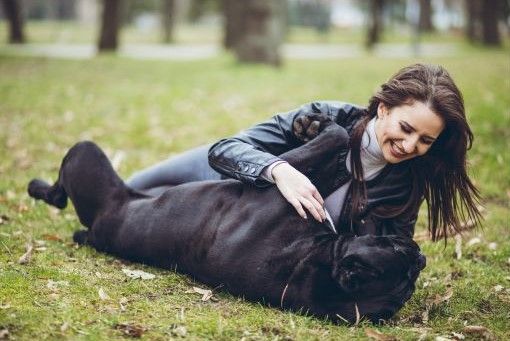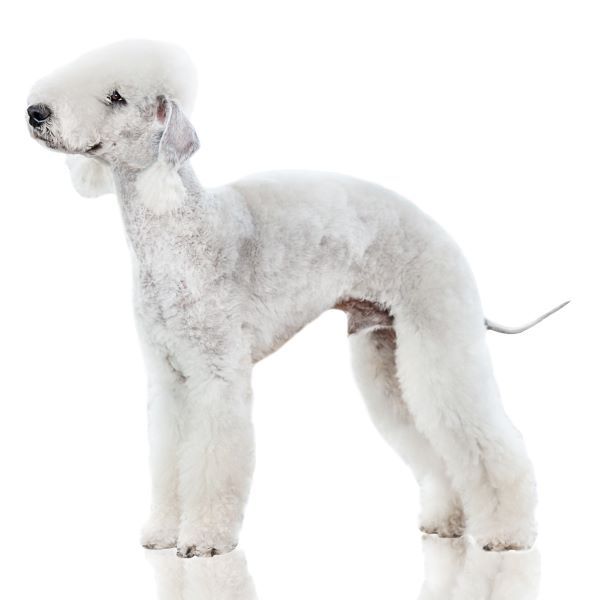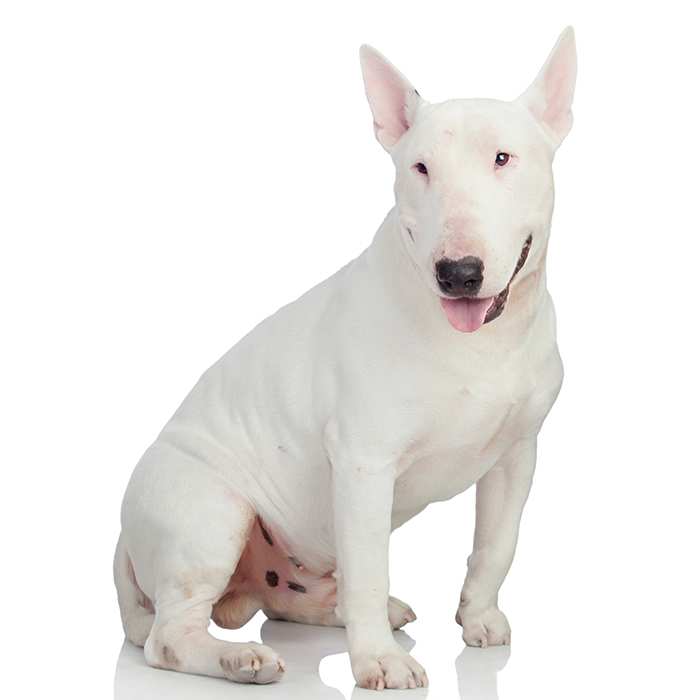Neapolitan Mastiff
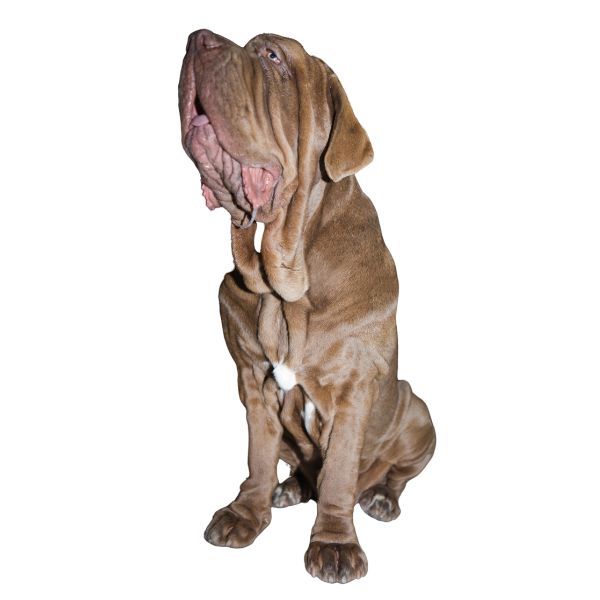

| Recommended for | Experienced dog owners with a large fenced yard; not ideal for apartment living or homes with very small children |
| Breed Classification | Working group |
| Other names | Mastino Napoletano, Italian Mastiff, Mastino, Neo |
| Lifespan | 8 to 10 years |
| Size | Giant |
| Temperament | Protective, stubborn, fearless |
| Intelligence | Above average |
| Tendency to bark | Low, but they will bark if they sense danger or are disturbed. |
| Maintenance Level | Moderate grooming needs due to their wrinkled skin and tendency to drool. |
| Health Risk | High probability of health issues during its lifetime, hence it is one of the more expensive breeds to insure. |
Insuring a Neapolitan Mastiff?
Get our award-winning Nose-to-Tail Cover with up to $30k annual benefit limit, up to 90% of eligible vet bills back, and no sub-limits.
Get a quick quote
Is this breed right for you?
Try our breed selector quiz to find out your best matching breed!
Insuring a Neapolitan Mastiff?
Get our award-winning Nose-to-Tail Cover with up to $30k annual benefit limit, up to 90% of eligible vet bills back, and no sub-limits.
Get a quick quote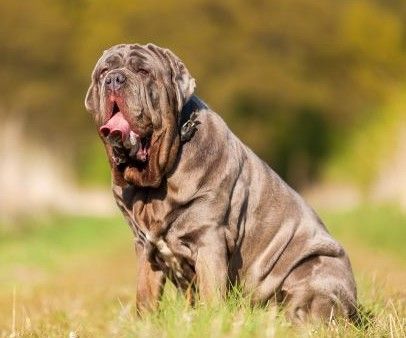
Breed history of Neapolitan Mastiffs
The Neapolitan Mastiff, often called the “Mastino Napoletano,” is a breed with a rich and ancient history dating back more than 2,000 years. It is widely believed that this giant guardian descends from the Molossus, a fierce war dog used by the Roman Empire. These large, muscular dogs were not only companions to Roman soldiers but also served as protectors of estates, guarding homes and livestock with unwavering loyalty.
The primary role of the Neapolitan Mastiff was to act as a protector, and their intimidating size and appearance certainly helped them excel in this role. With their loose, wrinkled skin and muscular build, these dogs were well-equipped to defend against potential threats. Their loose skin wasn’t just for show – it provided a practical defence mechanism, allowing the dog to turn and fight back even if grabbed by an attacker.
For many centuries, the breed remained relatively unknown outside of Italy, where it was a favourite among Italian nobles and farmers alike for its ability to guard homes and livestock. By the mid-20th century, however, the breed had come dangerously close to extinction. The devastation of World War II left many dog breeds struggling, but the Neapolitan Mastiff was saved thanks to the efforts of dedicated breeders who recognised the importance of preserving its unique qualities. Italian breeders worked tirelessly to restore the breed, selecting only the finest dogs with the right temperament and physical traits.
These breeders ensured that the Neapolitan Mastiff retained its signature characteristics: its loose, wrinkled skin, calm but protective nature, and imposing stature. Through their efforts, the breed slowly began to make a comeback. In the 1940s, the Neapolitan Mastiff started gaining attention outside Italy when it was exhibited at dog shows.
Kennel clubs, including the Italian National Kennel Club (ENCI), played a crucial role in standardising the breed’s features, ensuring that the Neapolitan Mastiff we see today retains the characteristics that have made it such a formidable guardian throughout history. Today, the Neapolitan Mastiff is admired not just for its size and strength, but for its deep loyalty and protective instincts.
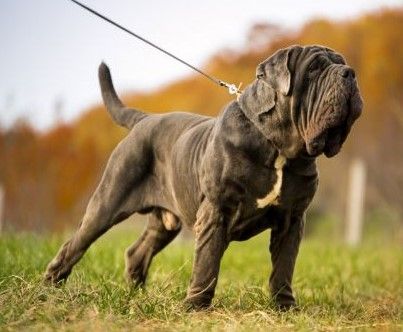
Physical description of Neapolitan Mastiffs
The Neapolitan Mastiff is a giant, powerful breed with a solid, muscular build, perfectly suited for protection. Its broad head, deep-set eyes, and wide muzzle give it a confident, imposing presence.
One of its distinctive features is its loose, wrinkled skin around the face and neck, giving it a sagging, heavy expression. The short, dense coat requires minimal grooming and comes in striking colours like black, blue, mahogany, and tawny, sometimes with brindle patterns.
| Weight range | Males: 60–70 kg, Females: 50–60 kg |
| Height range | Males: 66–79 cm, Females: 61–74 cm |
| Colours | Primarily black, blue, mahogany, or tawny, with brindle patterns appearing in any of these base colours. |
| Coat length | Short |
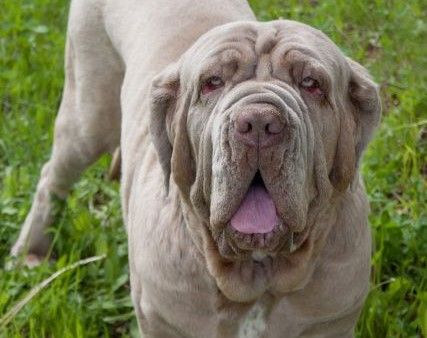
Neapolitan Mastiff personality and temperament
Neapolitan Mastiffs are known for their calm and composed temperament, coupled with a strong protective instinct. Bred to be loyal guardians, they have an innate ability to defend their family and property with unwavering courage. Despite their large and intimidating appearance, these dogs are incredibly affectionate and form deep bonds with their families. Their calm nature makes them wonderful companions, though they are always watchful and alert to potential threats.
Although independent, Neapolitan Mastiffs thrive on family interaction. They enjoy participating in activities like play, training, or simply being close to their loved ones. They are known for following family members around the home, preferring companionship over solitude. Ensuring regular interaction is key to their emotional well-being, as prolonged isolation can lead to anxiety or restlessness.
While naturally protective, Neapolitan Mastiffs are not aggressive unless provoked. Their calm and confident demeanour makes them reliable in a variety of situations, both at home and in public. This loyalty, combined with their natural guarding instincts, makes them excellent watchdogs, always prepared to defend their family if needed.
Despite their size and strength, they have a gentle, loving side that shines through in family interactions, making them fantastic companions in the right household. Their ability to balance being a formidable guardian with affection for their family makes them truly unique and highly valued as both protectors and companions.
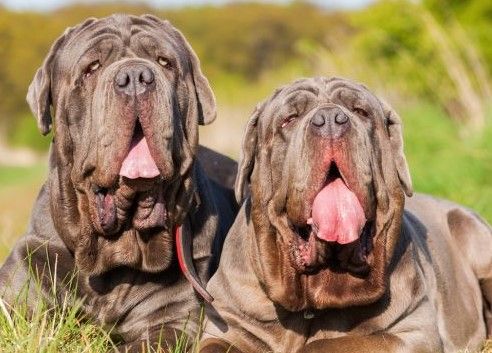
Neapolitan Mastiffs with kids and other pets
Neapolitan Mastiffs make gentle and loyal family companions, particularly suited to households with older children. With their calm and protective nature, they often take on a nurturing role, keeping a watchful eye over their family. While patient with kids, it’s important to supervise playtime due to their large size and strength, as accidental knocks can easily happen.
When it comes to other pets, Neapolitan Mastiffs generally get along well, especially if they’re raised together from a young age. Early socialisation is essential to prevent any dominance or territorial behaviours from developing. Their protective instincts are strong, and while they are typically gentle, consistent training and supervision are key to ensuring harmonious interactions, particularly with smaller animals.
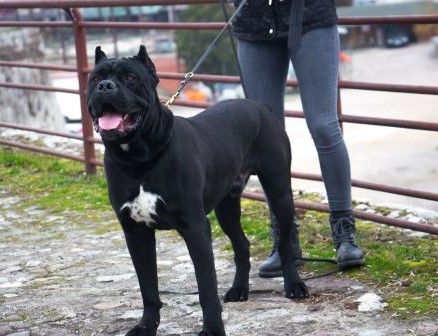
Neapolitan Mastiff training and exercise
Neapolitan Mastiffs need regular physical activity and mental stimulation to stay healthy and well-balanced. Despite their large size, they aren’t overly energetic and tend to prefer calm observation over intense activity. Daily walks and moderate play sessions are important to keep them in good shape.
Mental stimulation, like puzzle toys, problem-solving tasks, and teaching new commands, is equally crucial to prevent boredom and any destructive behaviour.
As an independent breed, Neapolitan Mastiffs thrive with consistent, positive training. Early socialisation is essential due to their size and strong protective instincts. They respond well to patient, reinforcement-based training, helping them understand their role in the family and promoting respectful behaviour.
Establishing clear boundaries from an early age is important to manage their natural guardian instincts, ensuring they grow into obedient and well-mannered companions.
| Energy level | Low to Moderate |
| Exercise requirements | Moderate |
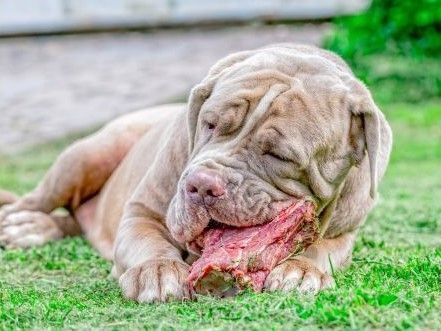
Neapolitan Mastiff feeding and nutrition
The health and well-being of a Neapolitan Mastiff rely heavily on proper nutrition, given their large size and muscular build. They require a balanced diet tailored to meet their specific energy and nutritional needs.
To keep them healthy, maintain their coat, and support their overall wellness, it’s important to feed them high-quality dog food formulated for large breeds. Consulting a vet is key to developing a feeding plan that suits their life stage and unique dietary requirements.
Nutritional needs change as Neapolitan Mastiffs age. Puppies need a protein-rich diet to support rapid growth, while adults benefit from a balanced diet to maintain energy levels and muscle mass. Seniors may require lower-calorie food and supplements to support joint health.
It’s important to adjust portion sizes based on their age, size, and activity level to avoid overfeeding and obesity. Regular check-ups with a vet will help monitor your dog’s weight and nutritional needs, ensuring they stay healthy and well-nourished throughout their life.
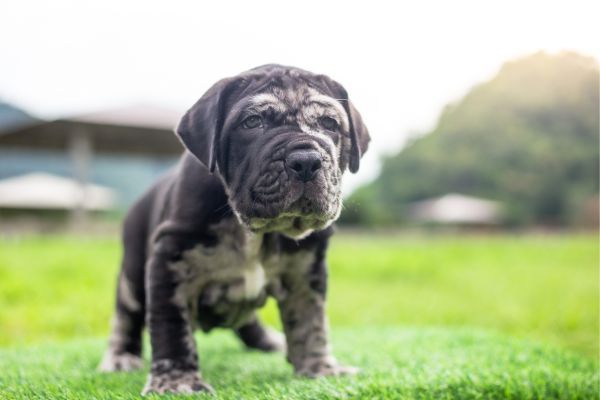
Neapolitan Mastiff care and grooming
Neapolitan Mastiffs need regular grooming to keep their skin and coat in top condition. While their short, dense coat sheds moderately, their loose, wrinkled skin requires special attention to prevent infections. Brushing once or twice a week helps remove loose hair and maintain a healthy coat. During shedding seasons, more frequent brushing may be necessary to manage excess hair.
Bathing should be done as needed, making sure to clean and thoroughly dry the skin folds to prevent irritation or infections. Regular grooming should also include trimming their nails, cleaning their ears, and maintaining good dental hygiene.
Given their large size and wrinkled skin, Neapolitan Mastiffs don’t require extensive coat trimming, but keeping the skin folds clean is crucial for their overall health. Avoid shaving, as their short coat naturally provides protection. Regular vet check-ups are important to monitor for any skin issues or other health concerns.
Health issues for Neapolitan Mastiffs
- Hip Dysplasia is a common concern in Neapolitan Mastiffs, where improper hip joint development causes instability and arthritis. It’s largely inherited, but factors like rapid growth, excess weight, and improper exercise can worsen it. Symptoms include pain, lameness, and difficulty moving.
- Elbow Dysplasia affects the front legs, causing pain and lameness due to poor joint development. It’s influenced by genetics, but rapid growth and over-exercising young Mastiffs can increase the risk.
- Cherry Eye occurs when the gland of the third eyelid becomes inflamed or dislodged, forming a red, swollen mass. While not painful, it can cause irritation and often requires surgery.
- Bloat (Gastric Dilatation-Volvulus) is a life-threatening condition where the stomach fills with gas and twists, cutting off blood flow. Symptoms include a swollen abdomen, difficulty breathing, and restlessness. Immediate vet attention is critical.
- Entropion is a genetic eye condition where the eyelid rolls inward, causing irritation. Symptoms include tearing and discomfort, often requiring surgical correction.
- Heart Disease, particularly Dilated Cardiomyopathy (DCM), is common in this breed, weakening the heart muscle and causing poor circulation. Regular vet check-ups are essential for early detection.
- Hypothyroidism occurs when the thyroid gland underperforms, leading to weight gain, lethargy, and hair loss. Regular tests and medication help manage this condition.
- Skin Infections are frequent due to the breed’s loose skin, which traps moisture and debris. Regular cleaning helps prevent infections, though recurring issues may need vet attention.
As with many large breeds, Neapolitan Mastiffs may face health challenges that require regular veterinary care. It’s important to stay vigilant about any changes in mobility, eye health, or overall behaviour, and consult with a vet to manage these issues effectively.
Not all conditions are covered by Pet Insurance. For details of Bow Wow Meow Pet Insurance cover, refer to the Product Disclosure Statement.
Free engraved pet ID tag on sign up3
Customer Satisfaction
21 day cooling off
Easy to use Pet Portal


